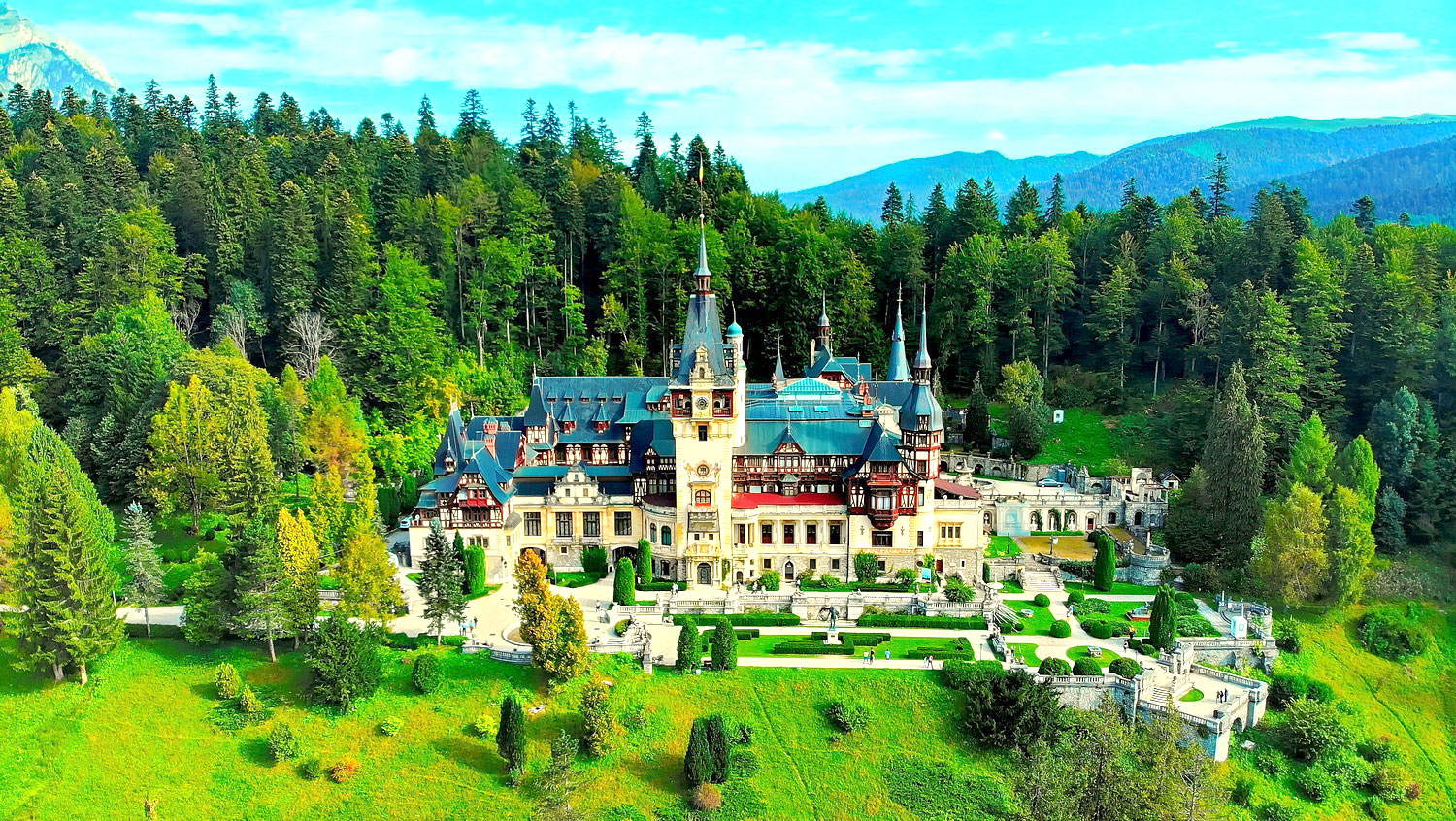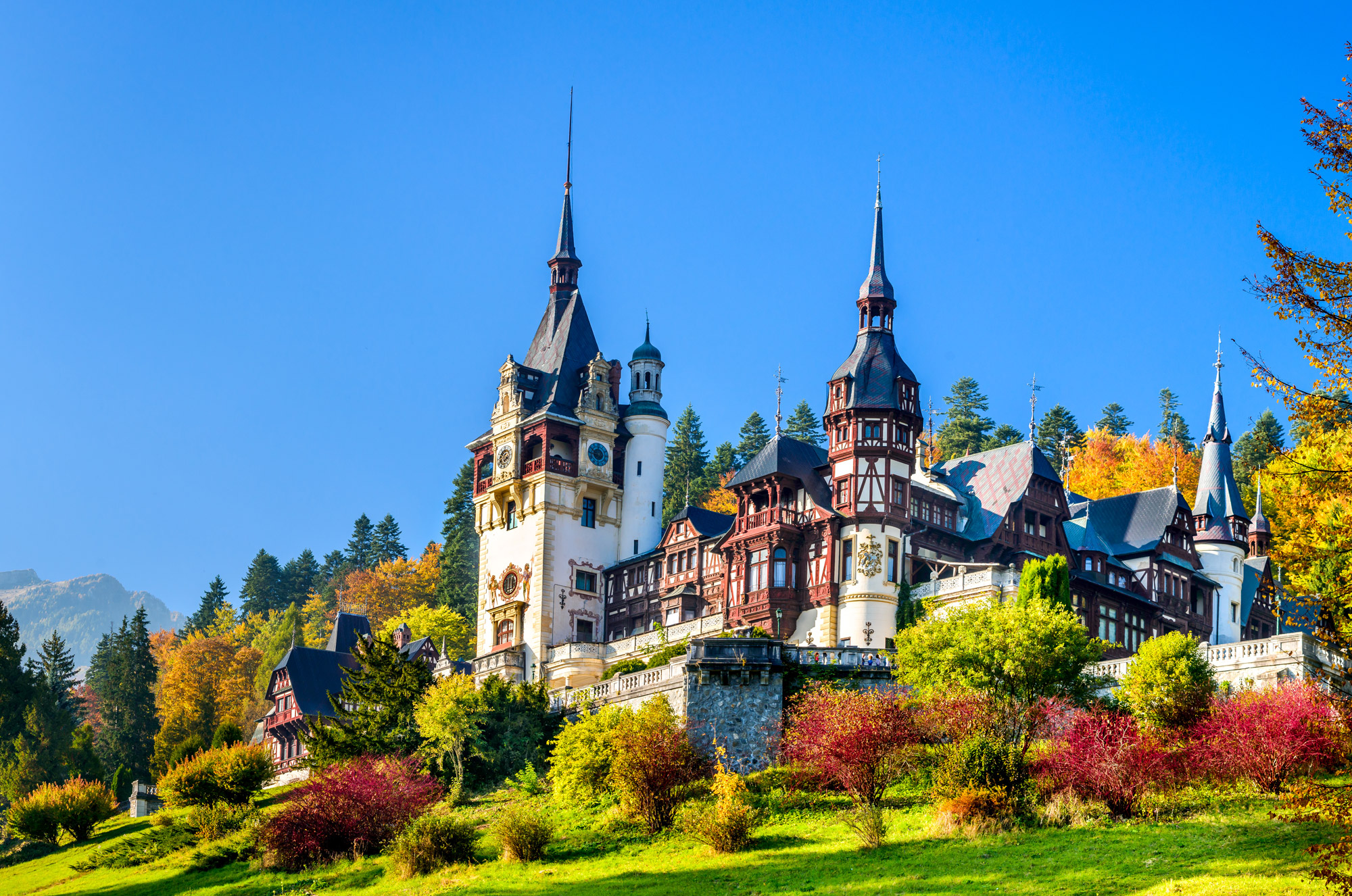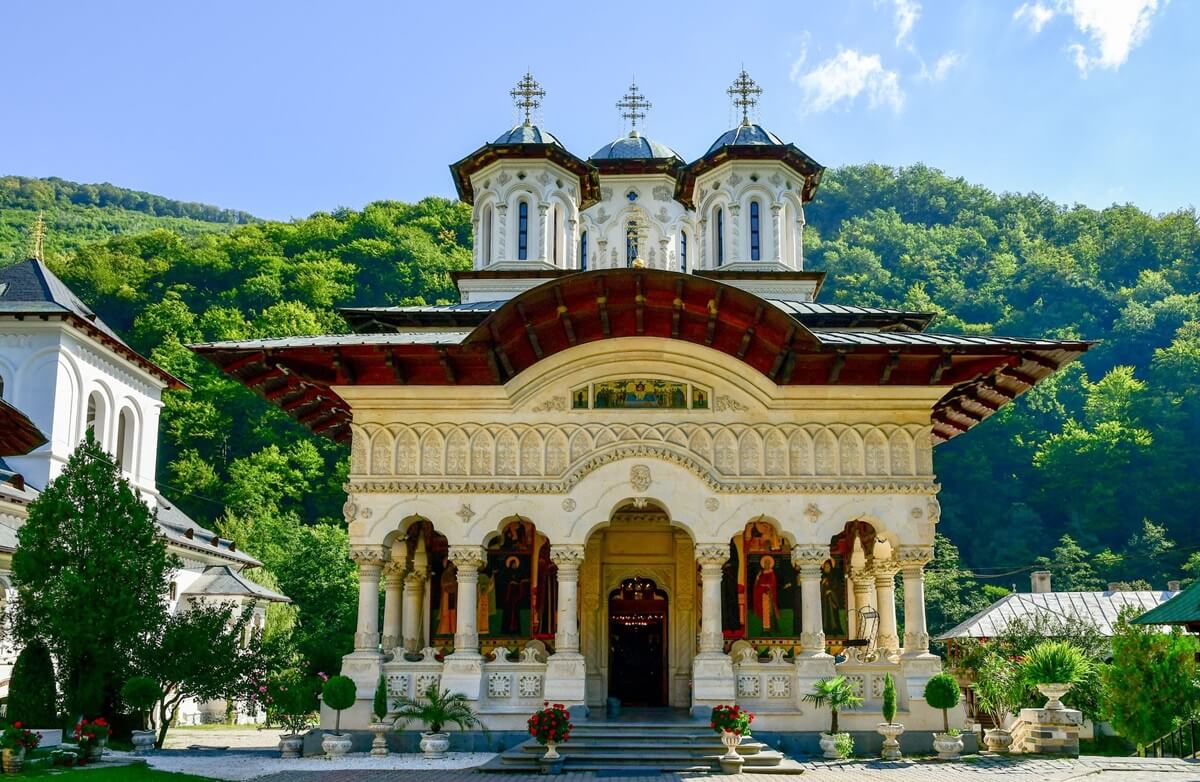
Nestled at the foot of Bucegi Mountains in the picturesque town of Sinaia, Peles Castle - considered by many one of the most stunning in Europe - is a masterpiece of German new-Renaissance architecture.
(Henri Blowitz, The Times Paris correspondent- passenger on the Orient Express Paris to Istanbul, 1883 maiden voyage).
Peles castle - Sinaia info
| Location: | town of Sinaia, Walachia region – Southern Romania |
| Address: | Str. Pelesului 2, Sinaia |
| Nearest cities: | Brasov (40 miles north) and Bucharest (80 miles south) |
| Nearest train station: | Gara Sinaia (1.2 miles SE) |
| Telephone: | (+4) 0244 310.918 |
| Visit planning: | Hours & Admission |
Commissioned by King Carol I in 1873 and completed in 1883,
Peles castle served as the summer residence of Romania's royal family, until 1947.
Peles castle's 160 rooms are adorned with the fine European art: paintings by great artists,
Murano crystal chandeliers, German stained-glass windows and Cordoba leather-covered walls.
Each room is decorated in a different style or theme.
There is a mini-Theatre, Music Room (India), Turkish Salon, Great Salon (Italy), Council Room (Switzerland), Moor Hall, and so much more.
Day-trip: Bucharest to
Peles and Bran castles and Old Town Brasov
Itinerary: Bucharest — Sinaia — Bran — Brașov — Bucharest
More information and reservations
The Royal Library (30,000 books) has a secret - unidirectional - door that leads to king's suite.
Castle's 60-seat Theater features Louis XIV - French classicism style.
Furniture in the Music Room is carved of teak, a gift to King Carol I from the Maharajah of Kapurtala in India,
while handmade silk embroideries adorn the ceiling and walls of the Turkish Salon.
Peles castle dining room features 18th-Century Brittany / Rustic Breton furniture and priceless silverware.
Politics and religion were topics never to be discussed at the dinner table. King Carol preferred topics were history and art.
King Carol I was an avid collector of weaponry; his collection numbered over 4,500 items.
Over 400 European and Oriental pieces dating from the 15th to the 19th centuries are on display at Peles armory;
the pièce de résistance being a knight and (his) horse armor that weights 265 lbs.

In 1899, king Carol I also commissioned the smaller, Art Nouveau, Pelișor Castle, located near Peleș castle.
Designed by architect Karel Liman and decorated by the Viennese artist Bernhard Ludwig,
Pelisor reflects Queen Mary's preferences for architectural style and decorations.
Pelisor's 70 rooms feature a unique collection of turn-of-the century Viennese furniture and Tiffany and Lalique glassware.
Built in less than three years, Pelișor Castle became the summer residence of Crown Princes Ferdinand and Maria,
the heirs to the throne in 1903.
Also worth exploring in Sinaia is Sinaia Monastery, founded by Prince Mihai Cantacuzino in 1695. Monastery Sinaia was named after the great Sinai Monastery on Mount Sinai. The royal family stayed at the monastery during their visits to Sinaia, before completion of Peles Castle. Today Monastery Sinaia is home to a small monastic community. Sinaia is also a popular destination for active travelers, interested in skiing, hiking, rock-climbing, mountain biking and wildlife watching.

...
How to reach Peles Castle, in Sinaia
Guaranteed-departure Tour, from Bucharest
Day-trip: Bucharest to
Peles and Bran castles and Old Town Brasov
Itinerary: Bucharest — Sinaia — Bran — Brașov — Bucharest
More information and reservations
Travel to Peles Castle using public transportation
The nearest train station to Peles castle is Sinaia.
There is frequent direct train and bus service to Sinaia from Bucharest, Brasov and Sibiu.
To check train/inter-city bus schedules please visit RomaniaTourism domestic transportation section.
Reaching Peles castle, by train or bus, from Bucharest, Brasov and Sibiu:
| Departing from | Train | Bus* |
|---|---|---|
| Brasov | train: Brasov to Sinaia, (1 hour and 10 minutes) |
bus: Brasov to Sinaia (one hour) |
| Bucharest | train: Bucharest to Sinaia, (1 hour and 30 minutes) |
bus: Bucharest to Sinaia (one hour and 50 minutes) |
| Sibiu | train: Sibiu to Sinaia (four hours) |
bus: Sibiu to Sinaia (connecting service, four hours and 45 minutes) |
| Sighisoara | train: Sighisoara to Sinaia (four hours and 30 minutes) |
bus: Sighisoara to Sinaia (three hours and 15 minutes) |
From Sinaia train station, visitors can reach Peles castle by foot (35 minutes walk), bus or taxi.
Local buses T1 and T3
take visitors from (near) Sinaia Train Station to Piateta Foisor bus stop
(10 minutes walk to Peles castle).
Town of Sinaia
interactive Street Map.
Book your 'tips-based' Sinaia Walking Tour.
Tip-based tours do not have a set ‘price’ and no upfront payment is required.
At the end of the tour each participant gives the guide the amount that she/he considers appropriate.
Taxi companies based in Sinaia include:
| Taxi Company | Telephone |
| Taxi Thomas | (+4) 0730 533.333 |
| Taxi Sinaia | (+4) 0732 844.390 |
| Taxi Super | (+4) 0729 999.666 |
| Taxi Raul | (+4) 0727 020.202 |
...
Reaching Peles Castle by car
Road distance and travel time to/ from Sinaia (Peles castle)
| Departure town | Distance | Travel Time* |
|---|---|---|
| Brasov | 30 miles | one hour and 5 minutes |
| Bucharest | 85 miles | one hour and 55 minutes ** |
| Sibiu | 120 miles | three hours and 15 minutes |
| Sighisoara | 105 miles | two hours and 40 minutes |
| Ploiesti | 42 miles | one hour and 10 minutes** |
| Targoviste | 44 miles | one hour and 30 minutes |
** Travel from Bucharest to Sinaia can take more than three hours on Fridays (afternoon) and Saturdays. .
...
Attractions not far from Peles Castle:
| Distance/ Direction | Attraction |
|---|---|
| 26 miles NW | Rasnov Fortress |
| 32 miles NW | Bran (Dracula) Castle |
| 30 miles N | City of Brasov |
| 22 miles W | Bucegi Mts. Nature Park |
| 30 miles N | Poiana Brasov - ski area |
| 32 miles NW | Brown Bear Sanctuary in Zarnesti |
| 45 miles SE | Dealu Mare wine region |
| 42 miles S | Town of Targoviste - Vlad the Impaler Princely Court |
| 88 miles S | Bucharest |
| 105 miles N | Sighisoara medival citadel, UNESCO World Heritage site |
| 115 miles NW | Town of Sibiu |
...
Peles Castle timeline and facts
August 5 – 6, 1866
King Carol I of Romania (1839–1914) visits, for the first time, monastery Sinaia and the small village Podu Neagului in the Carpathian Mountains.
The king liked very much the magnificent scenery just north of the village.
1872
The Crown purchases 1,236 acres (1.95 sq mi) of land at the northern edge of village Podu Neagului.
King Carol I anounces his desire to build a summer retreat, on the recently purchased Royal Domain.
Three design plans – resembling Loire valley castles and Ringstrasse (Vienna) palaces - are submitted by Austrian architect Wilhelm von Doderer;
the king rejects all of them because lack of originality and being too costly.
German architect Johannes Schultz presents a more original plan combining different features of classic European styles:
German aesthetics (hand-painted murals and ornate fachwerk) along Renaissance lines and Italian elegance. Schultz’s project is accepted.
Architect Carol Benesch is hired to co-lead construction of the castle.
1873 -- 1875
300 workers prepare the landslide prone site for construction of the castle.
Drainage is improved, angle of the slope is reduced and 708,000 cubic-feet of rock and dirt are excavated to unload the top of the slope of mount Molomoţ.
Excavated earth was removed by using a cable-car.
1874
At the initiative of king Carol I, village Podu Neagului is renamed Sinaia.
August 22, 1875
Works to build Peleș Castle begin.
A perchment (King’s statement) and several 20 Lei gold coins - limited edition - depicting portrait of king Carol I are embeded into the.
Peles castle becomes the first structure in Romania erected on a reinforced concrete foundation.
Locally-sourced building materials are used to build Peles castle.
1873 -- 1883
Several auxiliary buildings are built simultaneously with the castle: the guards' chambers, the „Economat” Building, the Foișor hunting lodge, the royal stables, and a power plant.
Peleș becomes the world's first castle fully powered by locally produced electricity.
1871 – 1882
While in Sinaia during construction of Peles castle, King Carol I and Queen Elizabeth lived in a small residence/villa,
part of Sinaia monastic complex. In 1895, King’s residence at Monastery Sinaia became a religious museum.
1883
Fire hydrants are being installed (manufacturer: Thiergärtner, Mainz - Germany).
The hydrants are still functional.
October 7, 1883
Peles castle welcomes his royal residents. The castles hosts its first Royal Ball.
Queen Elisabeth (of Wied) invites the passengers of the luxury train Orient Express,
Paris to Bucharest inaugural journey, to visit Peleș Castle.
During the visit, Carol I ceremoniously puts the last brick in place to celebrate the castle's completion.
1883 -- 1912
Carol I and his wife live in the castle from May until November.
1884 --- 1914
Several additions to Peles are made under supervison of Czech architect Karel Liman
Architect Liman also supervised the building of the nearby Pelișor Castle (1889–1903),
the future residence of King Ferdinand I and Queen Marie of Romania.
1884
Electrical System is installed. Peles becomes the first castle in Europe lit with electricity.
Electricity is provided b y castle’s own generator.
1890
A Moorish room is being created in the space initially dedicated to the (southern) Conservatory.
(architect: Émile André Lecomte du Noüy, a disciple of French architect Violet Le Duc).
October 15, 1893
Carol II of Romania, son of king Ferdinand I, is born in the castle.
1895 - 1897
Queen Elisabeth’s Chapel, Wied Princess and Hohenzollern princess apartments are completed.
1897
A hydropower plan is constructed. Waters of the nearby Peles stream are used to produce electricity needed for the castle.
1896
Franz Joseph I – Emperor of Austria, a friend of the Romanian Royal Family, visits Peles Castle.
Shortly after his visit to Peles, the emperor wrote in a letter:
The Royal Castle - amongst other monuments - is surrounded by extremely pretty landscape with gardens built on terraces,
all at the edge of dense forests.
The castle itself is very impressive through the riches it has accumulated:
old and new canvases, old furniture, weapons, all sort of curious, everything placed with good taste.
We took a long hike in the mountains, afterwards we picnicked on the green grass, surrounded by the Gypsy music.
We took many pictures, and the atmosphere was extremely pleasant.
During Franz Joseph I visit to Peles Castle, Romania renews her adherence to the Triple Alliance
(a secret agreement between Germany, Austria-Hungary, and Italy formed in May 1882 and renewed periodically until World War I).
Other royalties that were guests at Peles Castle include:
Empress Elisabeth (Sisi) of Austria,
Emma of Waldeck and Pyrmont - Queen of the Netherlands,
Gustaf V - King of Sweden,
Wilhelm II - German Emperor and King of Prussia,
Şehzade Yusuf Izzeddin - heir to the throne of the Ottoman Empire,
Alexander of Battenberg - prince (knyaz) of the Principality of Bulgaria,
Tsar Ferdinand I of Bulgaria,
Maria Theresa of Austria Este - Queen of Bavaria,
Crown Prince Rudolf and Stephanie of Habsburg - Royal House of Belgium,
Archduke Franz Ferdinand of Austria,
Friedrich Wilhelm - German Crown Prince and Crown Prince of Prussia,
Grand Duke Boris Vladimirovich of Russia,
Alfred - Duke of Saxe-Coburg and Gotha,
Charlotte and Bernhard III Frederick Wilhelm Duke of Saxa-Meiningen.
1900
A central vacuum system is a installed throughout Peles castle. The system, built in Austria by
Brevets Herz-Kozac (current name: BVC Zentalstaubsauger) is still in use today.
Beginning in 1975 the castle administration stoped using the device.
In 2011 the system the has been re-started and is still in use today.
1903 – 1906
The Marble Gallery, Concert Hall, the Little Music Room, queen’s bathroom,
several rooms on the second floor as well as guests’ apartments (north wing) are redecorated / completed..
1905 – 1906
Decorations of the vast Imperial Suite (Great Livingroom, little livingroom, bedroom, Budoir, Bathroom and butler’s room)
and apartment of hereditary heirs Ferdinand – Maria are completed.
Cost of decoration of the Imperial suite was 100,000 Lei (gold) – 1.2 million US Dollars.
1906
Peles castle’s main tower (215.5 feet) is completed.
The theatre hall, located on the main floor is being refurbished
(ceiling painting and decorative frieze by Austrian painters Gustav Klimt and Frantz Matsch).
Film projection technology is installed;
first film screening in Romania takes place.
1907
A three-cadran (faces) clock is installed atop Peles main tower. (source: Bavaria’s Royal court clock manufacturer - Johann Mannhardt).
The Old Music Room, the Florentine Hall and the Colonnade hall are (re)decorated (architects: Karel Liman and Ferdinand de Tiersch).
The Royal dining Room is enlarged and an apartment for the Prime Minister is built.
1907 -- 1911
Peles castle’s second inner court is transformed into the Honor Hall / main reception room.
The sculpted wood pannels in the Honor Hall depict 2,000 persons and characters.
140 artists worked non-stop for a little over six-months to complete this unique workk of art.
The Honor Hall has a sliding double-roof: a spectacular stained glass roof protected by a glass roof
that also allows more natural light – when stained glass roof retracted - during cloudy days; the roofs slide independently.
Cost for completing the Hall of Honor was 1.5 million lei (gold) – approx. 18 million US Dollars.
The lobby is re-decorated in German Renaissance style with subtle baroque accents
(architects: Bernhard Ludwig and Karel Liman; design inspired by Fredenhagen Hall - Chamber of Commerce Palace, Lübeck - Germany.
The Weaponry/ Trophy room (Sala Armelor is completed.
A Chess room and a Billard room are being added (next to the Moorish Room).
1906 – 1914
The exterior terraces are expanded.
1911 -- 1914
The Council Hall (Sala Consiliilor) is completed (Liman and Bernhard Ludwig).
A terrace that displays a collection of sculpted busts of Roman emperors is built (south-east wing of Peles).
1914
Peleş castle was open to visitors even before king Carol I death (1914).
In 1914 Peles becomes an aulic space and a museum and does not serve a a summer residence anymore.
1914 – 1947
Peles is an aulic space used to host official visits and military ceremonies.
1939
(c/o Societatea Concordia – Bucureşti) new, modern, film projection technology
is brought at Peles castle theatre (King Carol II special request).
1947
Communist authorities force King Michael I to abdicate and seize royal property, including the Peleș Estate.
The castle is opened to visitors, for a short time.
Peles also served as a recreation and resting place for Romanian cultural personalities.
1953
Pelas castle becomes a national museum.
1975 -- 1982
Peles is declared a "Official State Building" and it is closed to visitors.
Only high-rank foreign guests, maintenance and security personnel are permitted on the Royal Domain.
Heads of State hosted at Peles castle by Romania’s Communist leader Nicolae Ceausescu include:
Richard Nixon – President of the USA,
Yasser Arafat - Chairman of the Palestine Liberation Organization (PLO),
Muammar Al-Gaddafi - Revolutionary Chairman of the Libyan Arab Republic,
Gerald Ford – President of the USA,
Todor Zhivkov – de facto leader of People’s Republic of Bulgaria and
Erich Honecker – leader of German Democratic Republic.
1982 – 1990
Peles Castle is no longer used for official functions or state visits.
1990
Peleș Castle and Pelișor Mansion are declared national heritage sites and open to the public.
Vila Foișor serves as a presidential residence.
2006
The Romanian government announces the restitution of Peles Royal Domain - to the former monarch, King Michael I.
2007
Peles castle is leased by the royal family to the Romanian government to be run as a museum and educational site.


